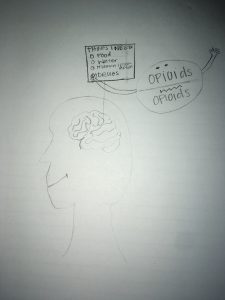Addiction is an issue continuously growing worldwide. This disease is most commonly associated with drug use but it can also entail other activities that can have addictive characteristics as well, such as social media, video games, gambling and many other things of that nature. When one becomes addicted to drugs or any activity, the reward pathways in their brain are being altered which is when the addiction sets in.
games, gambling and many other things of that nature. When one becomes addicted to drugs or any activity, the reward pathways in their brain are being altered which is when the addiction sets in.
What’s changing in the brain?
In a person that is not suffering from addiction, the reward pathways reinforce behaviors that are beneficial and necessary for survival (eating, drinking, sex and social interactions). Drugs that are abused or other sources of addiction alter this system so that using the drug becomes a necessary behavior. In the regular function of this pathway, dopamine is transmitted from the ventral tegmental area (VTA) of the midbrain to the limbic system and pre-frontal cortex where it binds to dopamine receptors to give the pleasurable or rewarding effect of these necessary behaviors.
An increase in dopamine levels is what is common to all forms of addiction. This continuous overstimulation is what causes the prolonged and stronger sensation of euphoria. The constant exposure to this higher level of dopamine desensitizes the reward pathway which then becomes no  longer sensitive to the everyday stimuli leading to the drug being the only stimulus to create this feeling of pleasure. The drug then eventually becomes less effective in creating this pleasure feeling and higher doses are needed to achieve the same feeling which can lead to overdose.
longer sensitive to the everyday stimuli leading to the drug being the only stimulus to create this feeling of pleasure. The drug then eventually becomes less effective in creating this pleasure feeling and higher doses are needed to achieve the same feeling which can lead to overdose.
D1 and D2 dopamine receptors are affected in this disease. These rapid increases of dopamine activate the reward pathway through the D1 receptors which amplifies the reward pathway. On the other hand, this dopamine surge also activates the D2 receptors which inhibits the ‘punishment’ pathway. Therefore, this doubles the effect by producing reward and also removing punishment.
Due to these changes in the brain, even one time using an addictive substance can lead to the development of addiction. When the brain changes, it is re-wired to crave these addictive things as a necessity like it should crave food, water and other stimuli required for survival. It is because of this it is a disease, not a decision to continue using these drugs of abuse. Additionally, addicts are likely to relapse because the pathways in their brain have been changed, so re-exposure to the substance of abuse could lead them back down that path of addiction.
Risk Factors
Social and environmental pressures are very common surrounding drug use. It is seen on TV and in movies and even at school for some adolescents . People can become exposed to these substances of abuse through pressure from peers, being bullied and feeling lonely. However, genetic factors, depression, lack of confidence and other illnesses can increase the risk of developing an addiction. About 10% of people who experiment with drugs become addicted at some point. Therefore, it is important to know and recognize the risk factors, because it is so easy to become hooked even if a person only tries something once or twice.
How can addiction be treated?
Addiction is usually treated with a combination of medication and behavioral therapies. There is also a new medical device called the NSS-2-Bridge which is a device that gets placed behind the ear and sends electrical pulses to stimulate certain nerves to help reduce opioid withdrawal symptoms.
Methadone– an opioid agonist which impacts the same type of neurotransmitter and therefore stimulates it in the same way an opioid drug would, but in a more controlled safer way. This is used in detoxifying a person suffering from addiction.
Naltrexone-an opioid antagonist which specifically blocks opioids at their receptors and used in patients who are already detoxified. This medication can also be used to treat alcohol addiction because it blocks the opioid receptors in the reward pathway which helps suppress the craving to drink.